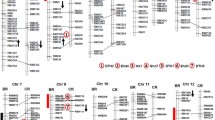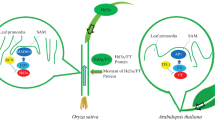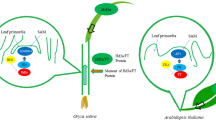Abstract
Differentiation in photoperiodic response of flowering has been key to the evolution and wide geographic distribution of rice, an essentially short-day plant. Crosses were made such that the hybrid F1 plants flower later than the late-flowering parents to investigate the genetic basis underlying this differentiation. From initial experiments, three major genes for flowering time were identified from four naturally occurring variants under natural long-day conditions. An F2-derived trigenic mutant line bred-true for a day-neutral response was selected and used as the recipient to synchronize the genetic background for the major genes. Experiments conducted under various daylengths indicated that these genes are responsible for photoperiodic sensitivity and the trihybrid has a critical daylength between 13.5 and 14 h. The three genes regulate photoperiodic responses qualitatively and quantitatively through complementary and other epistatic effects, respectively. The complementation suggests that the three genes act in a linear manner to repress the transition from the vegetative to reproductive phases under long daylengths. This set of genes also provides a model to understand the genetic mechanism underlying the elongated vegetative growth period in the F1 generation, which is usually an obstacle to the use of heterosis, and the selection for early maturation in rice breeding.
Similar content being viewed by others
References
Chandraratna, M. F., 1953. A gene for photoperiod sensitivity in rice linked with apiculus colour. Nature 171: 1161–1163.
Chang, T. T., C. C. Li & B. S. Vergara, 1969. Component analysis of duration from seeding to heading in rice by the basic vegetative phase and the photoperiod-sensitivity phase. Euphytica 18: 79–91.
Cai, C.-M., W.-M. Li & Y.-C. Zhou, 1987. Complementary genes controlling photoperiod sensitivity in hybrid rice. Rice Genetics Newsletters 4: 90–91.
Fujino, K., 2003. Photoperiod sensitivity genes controlling heading date in rice cultivars in the northernmost region of Japan. Euphytica 131: 97–103.
Garner, W. W. & H. A. Allard, 1920. Effect of relative length of day and night and ohter factors of the environment on growth and reproduction in plants. Journal of Agricultural Research XVIII: 553–606.
Garner, W. W., 1933. Comparative responses of long-day and short-day plants to relative length of day and night. Plant Physiology 8: 347–356.
Gu, X.-Y. & M.-H. Gu, 1995. Genetic analysis of heading time in the crosses between >Lunhui 422=and indica varieties. Chinese J. Rice Sci.9: 21–26.
Gu, X.-Y. & M.-H. Gu, 1997. Inheritance of heading time in two middle indica cultivars of rice. Chinese J. Rice Sci. 11: 151–154.
Hayama, R., S. Yokol, S. Tamaki, M. Yano & K. Shimamoto, 2003. Adaptation of photoperiodic control pathways produces short-day flowering in rice. Nature 422: 719–722.
Ichitani, K., Y. Okumoto & T. Tanisaka, 1998. Genetic analysis of the rice cultivar Kasalath with speci c reference to two photoperiod sensitivity loci, E1 and Se-1. Breeding Science 48: 51–57.
Imuta, I., F. Kikuchi, I. Watanabe & M. Yusa, 1991. Genetic analysis of heading time by using linkage relationship with isozyme gene Pgi-2 in rice, pp. 708–709 in Rice Genetics II. The International Rice Research Institute, Manila, Philip-pines.
Kikuchi, F., 1997. Heading time and flowering, pp. 359-367 in Science of The Rice Plant 3. Genetics, edited by T. Matsuo, Y. Futsuhara, F. Kikuchi & H. Yamaguchi. Food and Agric. Policy Res. Center, Tokyo.
Koornneef, M., C. Alonso-Blano, H. B. Vries, C. J. Hanhart & A. J. M. Peeters, 1998. Genetic interaction among late-flowering mutants of Arabidopsis. Genetics 148: 885–892.
Li, C. C., 1970. Inheritance of the optimum photoperiod and critical photoperiod in tropic rices. Bot. Bull. Acad. Sinica 11: 1–15.
Li, D., S. Liang, Y. Qin & Q. Xuan, 1992. Photoperiod sensitivity and breeding approach of late indica hybrid rice in South China. Southwest China Journal of Agricultural Sciences 5: 1–6.
Li, H. & J. Zou, 1992. Expression and inheritance of heading date in hybrids between indica and japonica varieties. Jiangsu Journal of Agricultural Science 8: 7–12.
Lin, H. X., T. Yamaoto, T. Sasaki & M. Yano, 2000. Characterization and detection of epistatic interactions of 3 QTLs, Hd1, Hd2, and Hd3, controlling heading date in rice using nearly isogenic lines. Theoretical and Applied Genetics 101: 1021 –1028.
Li, Z., Z. Chen, G. Liu & J. Guo, 1980. A preliminary study on the genetic variation of heading date in rice. Acta Agron. Sinica 6: 179–188.
Mackill, D. J., M. A. Salam, Z. Y. Wang & S. D. Tanksley, 1993. A major photoperiod-sensitivity gene tagged with RFLP and isozyme markers in rice. Theoretical and Applied Genetics 85: 536–540.
Maheswaran, M., D. J. Mackill, N. Huang, S. R. Sreerangasamy & S. R. McCouch, 1999. Identification of RAPD markers linked to Se-3 (t ), a gene enhancing the level of photoperiod sensitivity in rice. Journal of Genetics and Breeding 53: 263–270.
Maheswaran, M., N. Huang, S. R. Sreerangasamy & R. S. McCouch, 2000. Mapping quantitative trait loci associated with days to flowering and photoperiod sensitivity in rice (Oryza sativa L.). Molecular Breeding 6: 145–155.
Morishima, H., 1984. Wild plants and domestication, pp. 3–30 in Biology of Rice, edited by S. Tsunoda & N. Takahashi. Japan Scientific Societies Press, Tokyo/Elsevier Amster-dam.
Nandi, H. K. & P. M. Ganguli, 1941. Inheritance of earliness in Surma Valley rices. Indian Journal Agricultural Science 11: 9–20.
Nomura, M. & R. Yamazaki, 1925. A study of the inheritance of the shooting time in rice plant. Japan Journal Genetics 3: 112–130.
Ohshima, I., F. Kikuchi, Y. Watanabe & C. Asahi, 1993. Genetic analysis of heading time in a cross between two indica varieties with inhibitor genes for photoperiod sensi-tivity. Japan Journal of Breeding 43: 101–106.
Oka, H. I. & W. T. Chang, 1960. Survey of variations in photoperiodic response in wild Oryza species. Bot. Bull. Acad. Sinica 1: 1–14.
Okumoto, Y., K. Ichitani, H. Inoue & T. Tanisaka, 1996. Photoperiod insensitivity gene essential to the varieties grown in the northern limit region of paddy rice (Oryza sativa L.) cultivation. Euphytica 92: 63–66.
Pan, X., 1981. Preliminary analysis of the heterosis in vegetative growth duration of the wild-pollen-abortion type of rice. Hereditas (Beijing) 3: 25–27.
Poonyarit, M., D. J. Mckill & B. S. Vergara, 1989. Genetics of photoperiod sensitivity and critical daylength in rice. Crop Science 29: 647–652.
Ramiah, K., 1933. Inheritance of flowering duration in rice (Oryza sativa L.). Indian Journal of Agricultural Science 3: 377–410.
Sethi, R. L., B. L. Sethi & T. R. Metha, 1936. Inheritance of earliness in United Provinces rices, I. Indian Journal of Agricultural Science 6: 1246–1273.
Sethi, R. L., B. L. Sethi & T. R. Metha, 1938. Inheritance of earliness in United Provinces rices, II. Indian Journal Agricultural Science 8: 1–20.
Shen, Z., Z. Lu & R. Li, 1965. Genetic analysis for some characters in the breeding of early-maturing and dwarf rice types. Acta Agron. Sinica 4: 391–402.
Syakudo, K. & T. Kawase, 1953. Studies on the quantitative inheritance (11). A. Rice (Oryza sativa L. )(d)Inheritance of the heading duration and the quantitative function of the causal genes in its determination. (1)On the quantitative function of the genes E1, E2 and D1. Japan Journal of Breeding 3: 6–12.
Syakudo, K., T. Kawase & K. Yoshino, 1954. Studies on the quantitative inheritance (13). A. Rice (Oryza sativa L. )(d) Inheritance of the heading period and the quantitative function of the causal genes in its determination. (2)On the quantitative function of the genes E3, E4 and D5. Japan Journal of Breeding 4: 83–91.
Thomas, B. & D. Vince-Prue, 1997. Photoperiodism in plants. Academic, London.
Vergara, B. S. & T. T. Chang, 1985. The flowering response of the rice plant to photoperiod, a review of the literature, 4th edn., International Rice Research Institute, Manila, Phil-ippines.
Yamamoto, T., Y. Kuboki, S. Y. Lin, T. Sasaki & M. Yano, 1998. Fine mapping of quantitative trait loci Hd-1, Hd-2 and Hd-3, controlling heading date of rice, as single Mendelian factors. Theoretical and Applied Genetics 97: 37–44.
Yano, M., Y. Harushima, Y. Nagamura, N. Kurata, Y. Minobe & T. Sasaki, 1997. Identification of quantitative trait loci controlling heading date in rice using a high-density linkage map. Theoretical Applied Genetics 95: 1025–1032.
Yano, M., S. Kojima, Y. Takahashi, H. X. Lin & T. Sasaki, 2001. Genetic control of flowering time in rice, a short-day plant. Plant Physiology 127: 1425–1429.
Yokoo, M. & H. Fujimaki, 1971. Tight linkage of blastresistance with late maturity observed in different indica varieties of rice. Japan Journal of Breeding 21: 35–39.
Yokoo, M. & F. Kikuchi, 1977. Multiple allelism of the locus controlling heading time in rice detected using the close linkage with blast-resistance. Japan Journal of Breeding 27: 123–130.
Yu, C. J. & T. T. Yao, 1962. Photoperiod studies on rice. I. The turning point between the short-day effect and the long-day effect in certain short-day varieties of rice. Bot. Bull. Acad. Sinica 2: 73–82.
Yu, C. J. & T. T. Yao, 1967. Photoperiod studies on rice. VI. Further studies on the turning point of the short-day effect and the long-day effect on certain short-day rice varieties. Bot. Bull. Acad. Sinica 8: 149–164.
Author information
Authors and Affiliations
Rights and permissions
About this article
Cite this article
Gu, XY., Foley, M.E. & Chen, ZX. A Set of Three Genes Regulates Photoperiodic Responses of Flowering in Rice (Oryza sativa). Genetica 122, 127–140 (2004). https://doi.org/10.1023/B:GENE.0000041003.12834.41
Issue Date:
DOI: https://doi.org/10.1023/B:GENE.0000041003.12834.41




